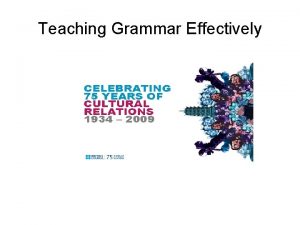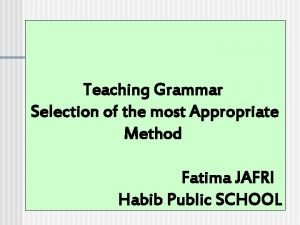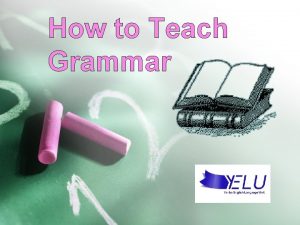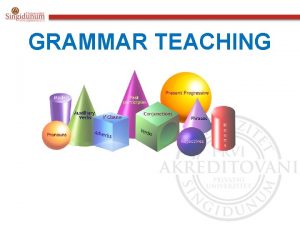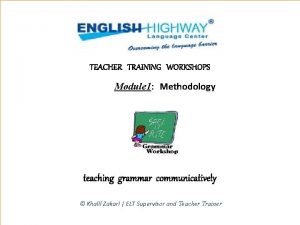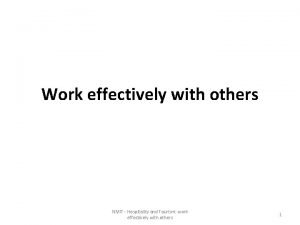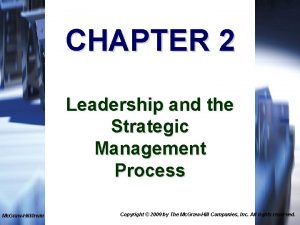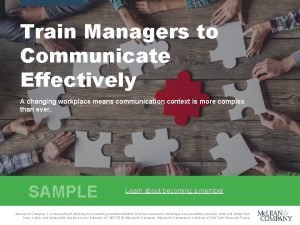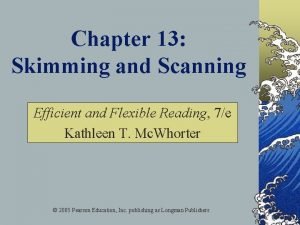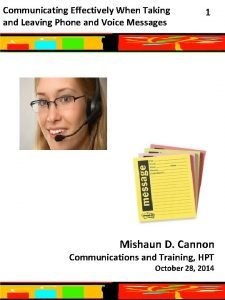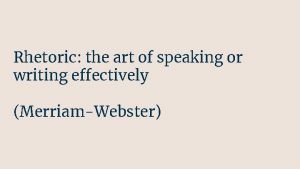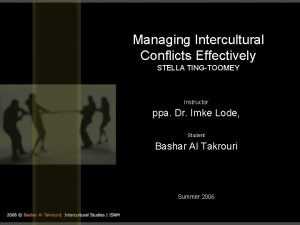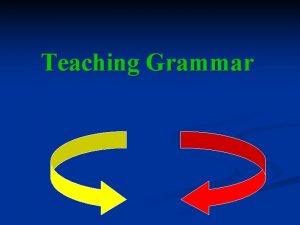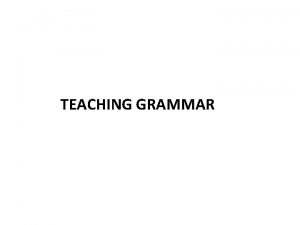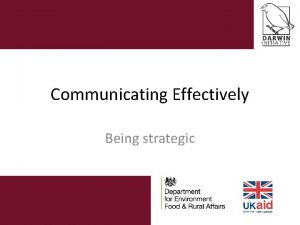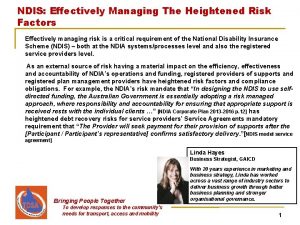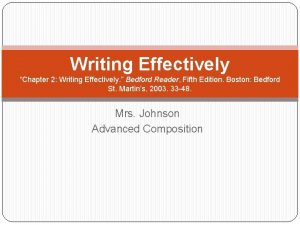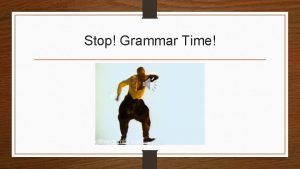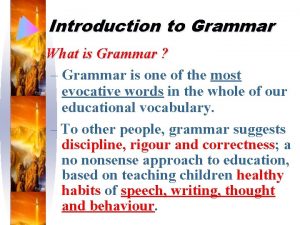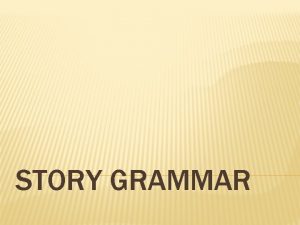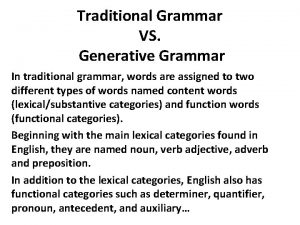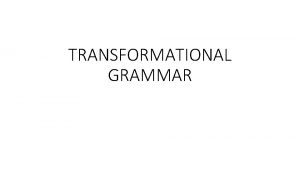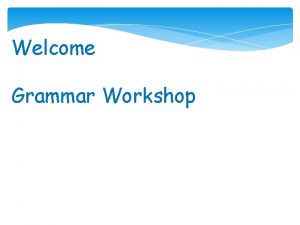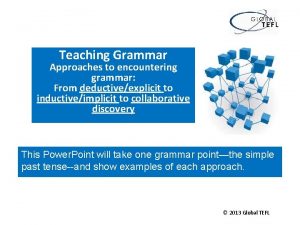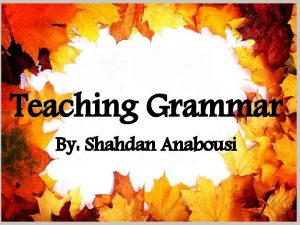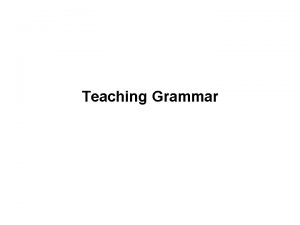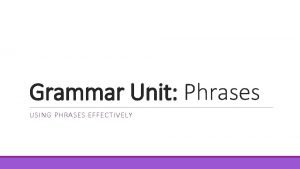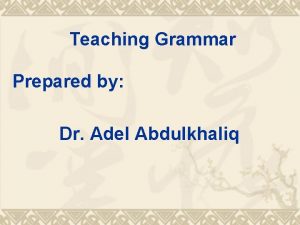Teaching Grammar Effectively Teaching Grammar Effectively Teaching Grammar






















- Slides: 22

Teaching Grammar Effectively

Teaching Grammar Effectively

Teaching Grammar Effectively What’s the best way to teach grammar?

Teaching Grammar Effectively The best way to teach grammar is …. . Some responses from teachers • • • Students need to understand the situation. Communicative way – first practice, then rule Deductive and inductive Test teach test Errors help them notice the gap. Creating situations for practice Understanding meaning from context Teachers need to present the rules. Asking concept questions Students need to notice the patterns and identify if right or wrong.

Teaching Grammar Effectively Noticing (a) Paying attention (b) Noticing the gap

Teaching Grammar Effectively Noticing tasks Two friends bump into each other in the street. Read their conversation then answer the questions which follow. 1 Sara Hi Jane, where are you going? 2 Jane The gym – I’m trying to get fit for my holidays, Sara. 3 Sara Oh good for you Jane. Are you doing a class? 4 Jane Yes – aerobics twice a week and I’m taking swimming lessons too. 5 Sara Oh, that’s a good idea. Listen, I need to get fit. I’ll come with you. 6 Jane That’s great Sara. By the way, I’m dieting too. 7 Sara Really? I won’t join you on that! In lines 1 -4 and 6, they use the present continuous form. Why? In lines 5 and 7 Sara uses the ‘will form’. Why? Is it possible to reverse this, ie, use will in lines 1 -4 and 6 and use the present continuous in lines 5 -7? What would the effect be?

Teaching Grammar Effectively Noticing tasks Look at the conversation on the left and compare it with the reported version on the right. Work with a partner and identify what changes are made to direct speech to make it into reported speech? Direct Speech Reported speech “Let’s go to a restaurant, ” she suggested. “I haven’t got any money, ” he said. “I’ll lend you some, ” she offered. “No, I don’t want to borrow any money, ” he said. “It doesn’t matter, ” she told him. “Let’s eat at home instead, ” he suggested. “All right, ” she agreed. She suggested going to a restaurant. He said he hadn’t got any money. She offered to lend him some. He said he didn’t want to borrow any money. She told him it didn’t matter. He suggested eating at home instead. She agreed that was all right.

Teaching Grammar Effectively The Textbook Strait-jacket Or Resource

Teaching Grammar Effectively Textbook exercises Complete the following sentences by choosing the present simple or present continuous She (look) for a job with EU in Brussels. She (speak) 5 different European languages so I (think) they’ll be interested in her. I (travel) to work by car, but I (want) to be more eco-friendly, so I (consider) other ways. I (read) a book about psychology in everyday life, but it’s very dull.

Teaching Grammar Effectively Textbook exercises • • • Complete the gaps with in or on Get …. . a bus Get …. . a car Get …. . a plane Get …. . . a boat Get …. . . a train Get …… a horse Get …… a taxi Get …… a tram Get. …. . . a bike Get ……. a motor-bike

Teaching Grammar Effectively Get on a bus Get on a plane Get on a train Get on a horse Get on a bike Get in a car Get in a taxi

Teaching Grammar Effectively Restructuring

Teaching Grammar Effectively Re-structuring Dictogloss

Teaching Grammar Effectively What is noticing? There are two main ways of noticing. Firstly, ‘Paying attention’, that is focusing on grammar when you are listening to something or someone, when you are reading something, engaged in a conversation, and even in completing grammar exercises. Secondly, there is ‘Noticing the gap. ’ This is where you become aware of how the way you use the language differs from the actual target forms. For example, you see something written down, you hear something someone says and it seems as if you are seeing or hearing it for the first time. In fact, you have probably seen or heard it before, but the difference is that you are ‘noticing’ it for the first time. Now that you have ‘noticed’ it you will start to see or hear it regularly and feel surprised that you never noticed it before.

Teaching Grammar Effectively Stop-go dictation Post speaking feedback Spot the difference Key word construction

Teaching Grammar Effectively Grammar in speaking tasks Nightmare or sweet dream?

Teaching Grammar Effectively My learners seem to forget all the grammar I have taught them. I only do activities where there is a clear grammar framework, so that they are forced to use target forms. My learners make lots of mistakes – too many to correct. It’s a waste of time correcting their mistakes because they never remember.

Teaching Grammar Effectively Speaking tasks Information gap Learners work in pairs A & B. They both have incomplete pictures of a town and have to ask each other questions to complete their pictures. Example language is given: Where is the cinema? It’s next to the supermarket? Where is the school? It is across from the park. Describe & draw Class work in pairs A & B. A has a picture of a person. S/he describes the picture to B – face, hair, eyes, clothes, height etc. B draws the picture described, using coloured pencils. They then compare pictures. Find someone who Class have a list of items, for example: Find someone who likes surfing the Internet/enjoys watching sports/doesn’t like working in pairs etc. They move around the class asking questions and noting names. Teacher practises the questions and responses before they begin. Role play Class role plays a restaurant. They are divided into waiters, restaurant managers and customers. They have a menu to choose from and some of them are instructed to complain about the food.

Teaching Grammar Effectively Planning time Choice Latitude Rehearsing time Feedback Reflection

Teaching Grammar Effectively Information gap Planning choosing and latitude: Prepare a sketch of a town or use the one in the textbook with the names of places blanked out. Ask class to brainstorm the kind of places they would like to see in their ideal town. Write their suggestions on the board. Divide the class into two groups, A & B. Give each group one of the lists. They then decide where they will situate the places on the list and write them in. Ask them to decide on the language they will use to describe their town to their partners in the other group and what questions they will ask to find out about their towns. Rehearse: Practise describing and asking questions. When they are ready divide into pairs – A & B to talk abut and compare their pictures. Feedback & reflection: Ask them what they noticed about each others’ descriptions – did they use the same language? Did they learn anything new from their partners? Was anything unclear? Did they have to restructure to help their partners understand? What would they do differently next time? Provide examples of other contexts where they could use this language.

Teaching Grammar Effectively Find someone who. . . Describe & draw Ask follow-up questions Make it a class survey Turn it into a ‘Spot the Difference’ activity Role play Learners ‘design’ the situation, decide who the‘players’ are and what roles they will play.

Teaching Grammar Effectively www. teachingenglish. org. uk
 Teaching grammar effectively cambridge
Teaching grammar effectively cambridge Assessing grammar effectively
Assessing grammar effectively Closure properties of regular languages
Closure properties of regular languages Left linear to right linear grammar
Left linear to right linear grammar What are the characteristics of traditional grammar
What are the characteristics of traditional grammar Type 0 grammar example
Type 0 grammar example Advantages and disadvantages of inductive method
Advantages and disadvantages of inductive method Teaching grammar for young learners
Teaching grammar for young learners Grammatical signals
Grammatical signals Covert grammar teaching
Covert grammar teaching Teaching and assessment of grammar module 1
Teaching and assessment of grammar module 1 Direct method of teaching english examples
Direct method of teaching english examples Work effectively with others
Work effectively with others An effectively worded strategic vision statement is
An effectively worded strategic vision statement is Effective communication
Effective communication Working effectively as a parent association
Working effectively as a parent association How to revise effectively
How to revise effectively Disadvantages of skimming reading
Disadvantages of skimming reading Effectively communicate meaning
Effectively communicate meaning How to effectively use twitter
How to effectively use twitter Short voicemail greetings personal
Short voicemail greetings personal The art of speaking and writing effectively
The art of speaking and writing effectively Stella ting toomey
Stella ting toomey
